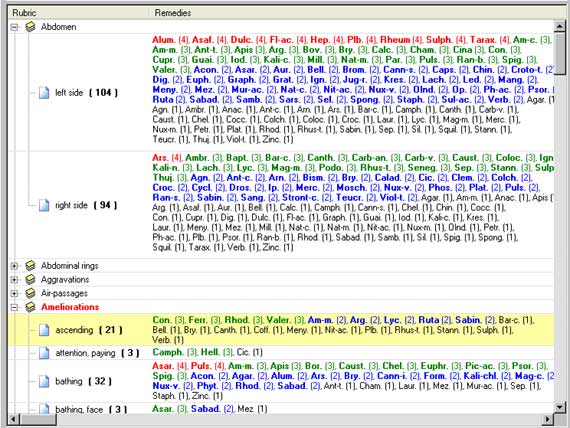|
|
Boenninghausen's repertory
Boenninghausen’s repertory was created by Baron Clemens Maria Franz von BOENNINGHAUSEN in 1846. Boenninghausen’s repertory offers a unique approach to the case-taking and evaluation of homeopathic cases.
Methodology
Boenninghausen’s repertory offers a unique approach to the case-taking and evaluation of homeopathic cases. Its methodology is very different from any other homeopathic repertories. While all other repertories try to record symptoms as accurately as possible along with all their modalities and conditions, Boenninghausen has assumed that when a patient displays a symptom, this symptom does not exist independently of the patient, but it represents the patient in its entirety. This means that if a particular symptom of patient is ameliorated by cold water, this modality is applicable also to the patient himself. We can then say that the patient is ameliorated by cold water.
This radical approach was not accepted by many masters of the classical homeopathy, although the logic of this approach is quite sensible. Many homeopaths have assumed that various symptoms can have various modalities that are not specific for the patient (e.g. pain in the knee ameliorated by warmth in a patient primarily aggravated by cold). The clinical practice has however confirmed that Boenninghausen’s method is successful and in many cases even more successful than the Kent’s method of repertorization. Many old masters of homeopathy have used Boenninghausen’s method, e.g. Caroll Dunham, Erasmus Case, T.F. Allen. One of the most successful prescribers - Erasmus Case said: “Unquestionably the best two repertories were compiled by Boenninghausen and Kent. Illustrations of their use are selected from records. In the study of chronic, obscure diseases with mixed symptoms, Boenninghausen's Repertory is the safest guide.”
In favor of the validity of Boenninghausen’s method speaks also an experiment conducted with a group of 15 homeopaths. Every homeopath from this group was presented with the same homeopathic case. 8 homeopaths used Kent’s repertory and 7 homeopaths used Boenninghausen’s repertory. Every homeopath has selected the correct remedy, but homeopaths using Boenninghausen’s repertory have repertorized the case considerably faster.
Boenninghausen’s approach is based on the idea that every symptom is composed of four basic components:
- Locality
- Condition
- Modality
- Concomitant
The locality describes the part of the body that is affected (e.g. Head, Extremities, Mind). The condition specifies the sensation or the pathology that is present (e.g. Pain, Nausea and Anxiety). The modality describes all the factors that change the symptom (aggravations, ameliorations) and the concomitant describes all the phenomena that occur simultaneously with the symptoms (e.g. Head pain with nausea).
All the symptoms in Boenninghausen’s repertory were decomposed into four basic components and this enables the homeopath to reconstruct any desired symptom by using the combination of four basic components. This unique approach of reconstructing symptoms rather than recording all the symptoms in their completeness enables to work with a more consistent and complete version of repertory than the Kent's repertory.
This means that rubric Internal head, forehead contains all remedies that produce any kind of condition (e.g. pain, constriction, sensation of heat, etc.) localized in the forehead.
The rubric Sensation, pain, dull contains all remedies that produce dull pain in any locality of the body (e.g. head, extremities, abdomen etc.).
The rubric Aggravations, bathing cold contains all remedies that have an aggravation by bathing in cold water.
The rubric Mind, associated symptoms contains all remedies that produce combination of symptoms concerning the Mind with other symptoms.
If we would like to reconstruct a symptom by using all four above-mentioned rubrics, we would create the following symptom: Dull pain inside of forehead that is aggravated by bathing in cold water and is accompanied by mind symptoms.
Structure
The structure of Boenninghausens repertory is composed of following rubrics:
- Mind (Mind, Intellect)
- Body parts (Internal head, External head, Eyes, Ears, Nose, Face, Teeth, Mouth, Throat, Mouth and fauces, Internal abdomen, External Abdomen, Abdomen, Hypochondria, Abdominal rings, Anus, Urinary organs, Sexual organs, Air-passages, External throat and Neck, Chest, Back, Upper Extremities, Lower
- Extremities, Glands, Bones, Skin)
- Bodily functions (Vision, Hearing, Smell, Hunger and thirst, Taste, Eructations, Nausea and Vomiting, Flatulence, Stool, Urine, Micturition, Menstruation, Leucorrhea, Respiration, Cough, Sleep, Position in Sleep, Dreams, Circulation)
- Sensations
- Aggravations
- Ameliorations
- Fever
The rubrics of Body parts, Mind and Body functions contain the Localities, Conditions and Concomitants.
The rubrics of Sensations and Fever contain mostly Conditions and Concomitants.
The rubrics of Ameliorations and Aggravations contain Modalities.
Translation
Mercurius contains the most commonly used translation of Boenninghausen’s Therapeutic Pocketbook translated by T. F. Allen. Although this translation was and is still most commonly used, it has contained several mistakes that were corrected according to the original German version.
Examples:
Original German Version
Gesicht, Abmagerung bloss des Gesichts
T.F.Allen translation
Face, Emaciation
Mercurius translation
Face, Emaciation (only the Face)
Original German Version
Gesicht (Sehen), Vergehen des Gesichts (-feldes, Dunkel-Schwarzwerden vor den Augen)
T.F.Allen translation
Vision, Vanishing
Mercurius translation
Vision, Vanishing (of Field of vision, Darkness before eyes)
Original German Version
Abneigung gegen Knoblauch
T.F.Allen translation
Aversion to Onions and Garlic
Mercurius translation
Aversion to Garlic

Back to repertories...
|
|
|









